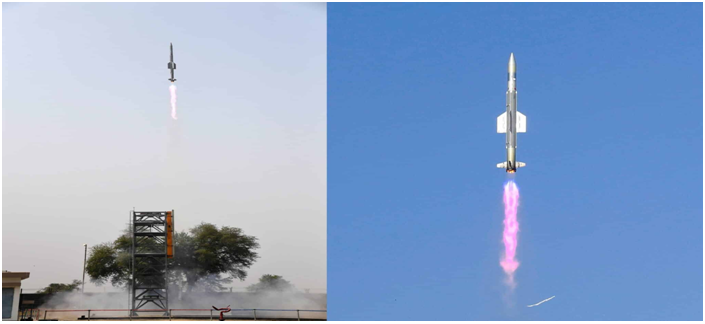DRDO & Indian Navy successfully flight-test VL-SRSAM (GS Paper 3, Science and Tech)

Why in news?
- Recently, the Defence Research & Development Organisation (DRDO) and Indian Navy successfully flight tested Vertical Launch Short Range Surface-to-Air Missile (VL-SRSAM) from the Integrated Test Range (ITR), Chandipur off the coast of Odisha.
The VL-SRSAM, a ship borne weapon system, is meant for neutralising various aerial threats at close ranges including sea-skimming targets.
Details:
- The flight test was carried out from an Indian Naval Ship against a high-speed unmanned aerial target for demonstration of vertical launch capability.
- The missiles, equipped with indigenous Radio Frequency (RF) seeker, intercepted the target with high accuracy.
- The VL-SRSAM system has been indigenously designed and developed by DRDO.
Salient Features:
- The missile has been designed to strike high-speed airborne targets at the range of 40 to 50 km and at an altitude of around 15 km.
- Cruciform wings: They are four small wings arranged like a cross on four sides and give the projective a stable aerodynamic posture.
- Thrust Vectoring: It is the ability to change the direction of the thrust from its engine, control the angular velocity and the attitude of the missile.
- Canisterised system: The inside environment is controlled, thus making its transport and storage easier and improving the shelf life of weapons.
Way Forward:
- During the test launch, flight path and vehicle performance parameters were monitored using flight data, captured by various Range instruments such as Radar, Electro-optical tracking system (EOTS) and Telemetry systems deployed by ITR, Chandipur.
- It will further strengthen the Indian Navy for neutralising various aerial threats at close ranges including sea-skimming targets.
Boeing 787 aircraft exempted from GAGAN
(GS Paper 3, Science and Tech)
Why in news?
The Civil Aviation ministry has exempted Boeing 787 aircraft from GPS-aided GEO Augmented Navigation (GAGAN) augmentation system compliance till 2025.

What is GAGAN?
- GAGAN is an augmentation system jointly developed by the Airports Authority of India and the Indian Space Research Organisation (ISRO).
- It provides a very accurate and high-level of satellite signals for precision air navigation over the entire Indian airspace, with the capability of expanding to nearby regions.
- It is capable of providing navigation services for departure, en-route and landing operations to equipped planes.
- GAGAN is a Satellite Based Augmentation System or SBAS, which is a regional network of ground stations and satellites that provide GPS signal corrections, giving a better position accuracy.
Uses:
- The use of the Gagan system helps reduce flight delays, save fuel, and improve flight safety.
- Moreover, it also facilitates aircrafts landing at airports not equipped with expensive Instrument Landing Systems including many small regional airports.
India signs headquarters agreement with CDRI, enables international status
(GS Paper 2, International Organisation)
Why in news?
- Recently, the Coalition for Disaster Resilient Infrastructure (CDRI) and the Government of India (GoI) signed a headquarters agreement.
What it translates?
- The agreement will enable the status of an 'Independent and International Legal Entity' for CDRIwith a Charter endorsed by 31 countries and eight international organisations in less than two years.
- The agreement will enable the institution to pursue functions internationally with all rights, immunities, and privileges, as per the United Nations (Privileges & Immunities) Act, 1947.
This will further enable the organization to fulfill its commitments and engagements on the resilience of infrastructure.

About CDRI:
- CDRI was launched by Prime Minister of India Narendra Modi at the UN Climate Action Summit in New York on 23 September 2019.
- The Coalition for Disaster Resilient Infrastructure (CDRI) is a partnership of national governments, UN agencies and programmes, multilateral development banks and financing mechanisms, the private sector, and knowledge institutions that aims to promote the resilience of new and existing infrastructure systems to climate and disaster risks in support of sustainable development.
- CDRI promotes rapid development of resilient infrastructure to respond to the Sustainable Development Goals' imperatives of expanding universal access to basic services, enabling prosperity and decent work.
China readying ring of telescopes aimed at Sun on Tibetan Plateau
(GS Paper 3, Science and Tech)
Why in news?
- China has been moving at a staggering pace when it comes to space exploration and is targetting not just Mars, but asteroids and distant planets in the future.
- But, before all that, China is geared up to introduce the world to the largest circular radio telescope array that will be aimed at the Sun.
Daocheng Solar Radio Telescope (DSRT):
- The construction of the Daocheng Solar Radio Telescope (DSRT) on the Tibetan Plateau is going ahead at full steam.
- It will be a network of 313 dishes spanning six meters wide that will study the sun in detail, going deeper into the mechanisms that cause the Coronal Mass Ejections.
The radio telescope will have a circumference of 3.14 kilometers as it images the Sun in radio waves and observes not just large eruptions, but also the changing activity of the star in our solar system.

What is Coronal Mass Ejection (CME)?
- Coronal Mass Ejection (CME) comes right after a star throws out a flare or a sudden and bright burst of radiation that can extend far out into space.
- A coronal mass ejection is one of the biggest eruptions from the Sun's surface that can contain a billion tons of matter accelerated to several million miles per hour into space.
- The telescope will be used to study CMEs and understand the phenomenon when magnetised plasma escapes from the sun’s upper atmosphere and propagates in space.
Chinese Meridian Project:
- The telescope is being developed as part of a Chinese Meridian Project (Phase II), a ground-based space environment monitoring network.
- The Chinese Meridian Project also includes the Mingantu interplanetary scintillation telescope, which is being assessed in Inner Mongolia.
- The facility will have 100 dishes in a three-arm spiral arrangement, which according to space.com, will study the sun in a wider band of frequencies than DSRT.
Part of the astronomy and archaeology park:
- The observatory is being developed as part of the astronomy and archaeology park in Daocheng, which is estimated at 7 billion yuan ($1.04 billion).
- The DSRT will therefore remain open to the public.
- The development is being led by the National Space Science Center (NSSC) of the Chinese Academy of Sciences.





